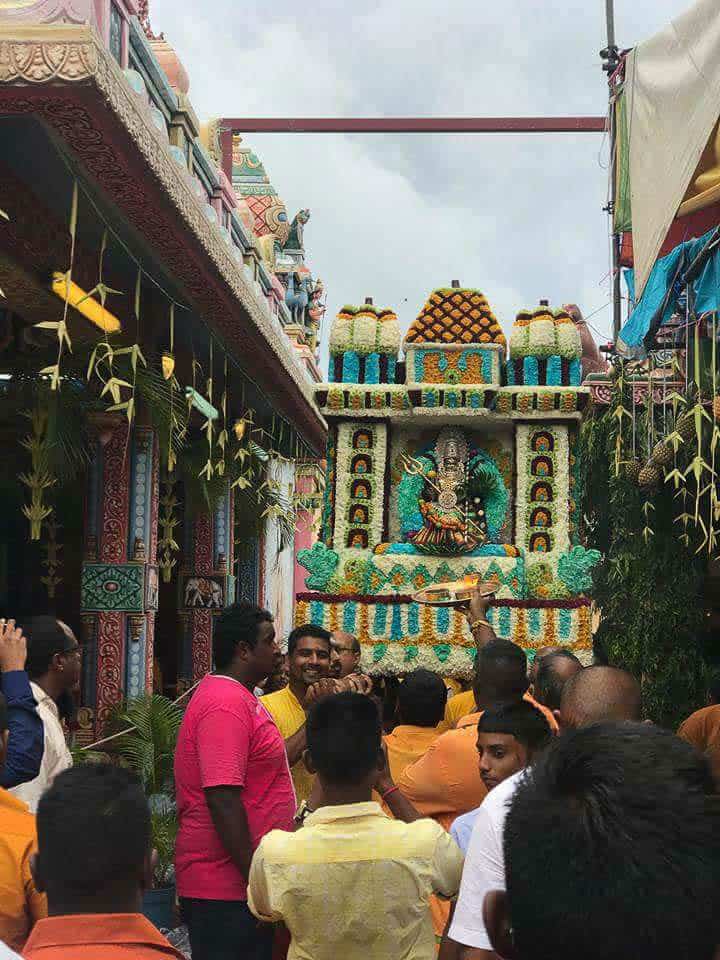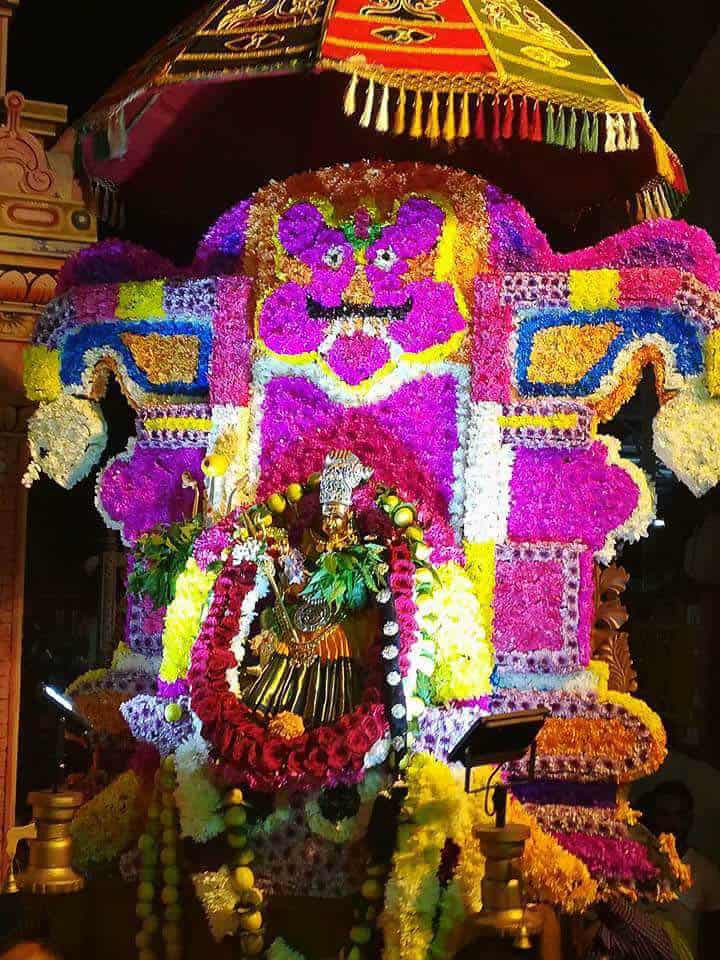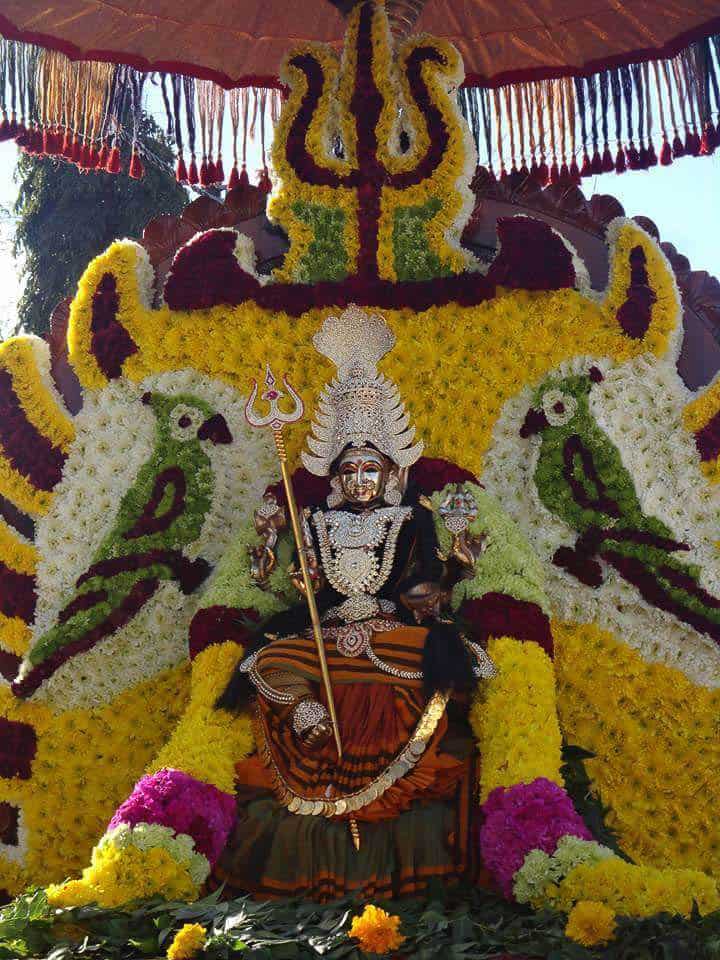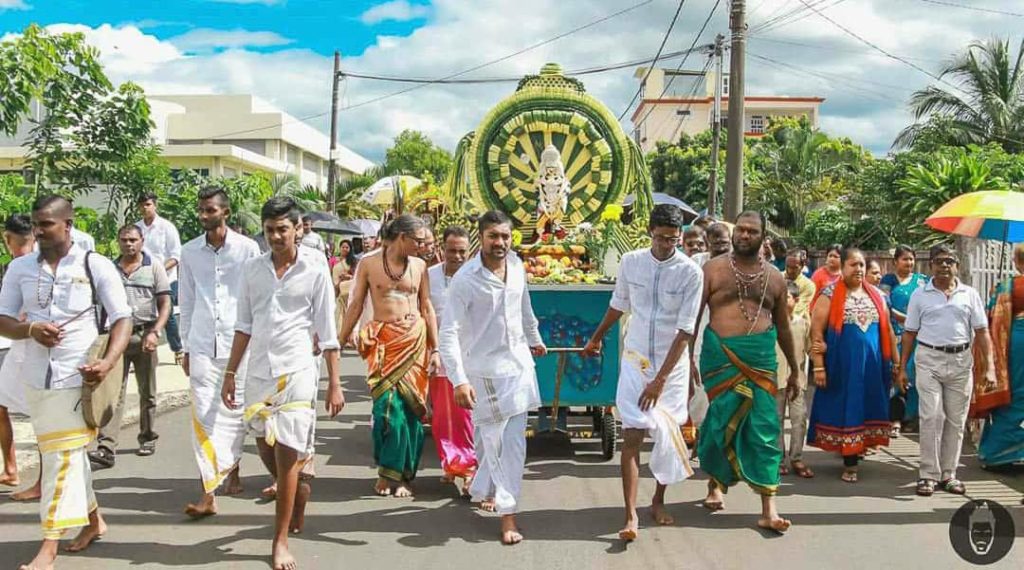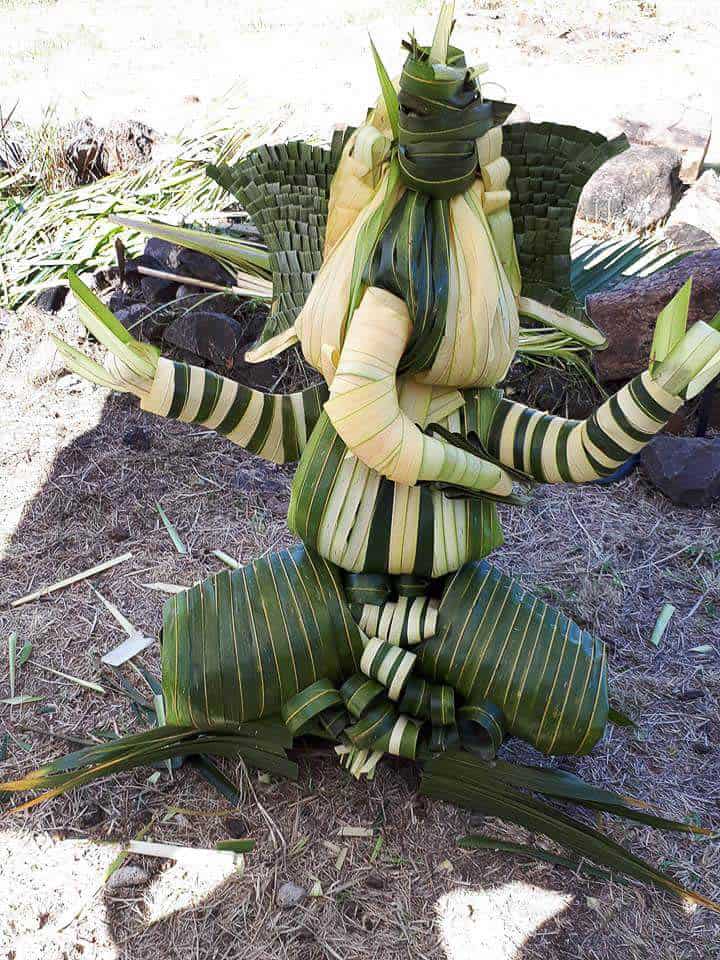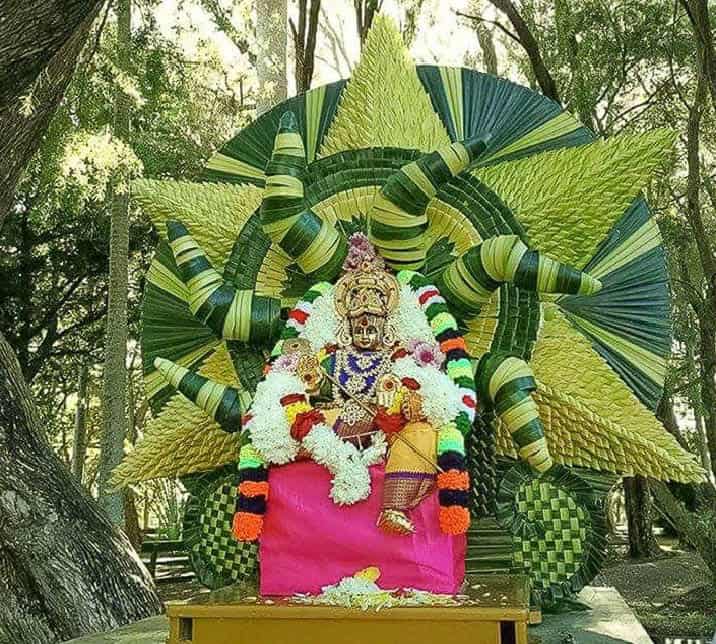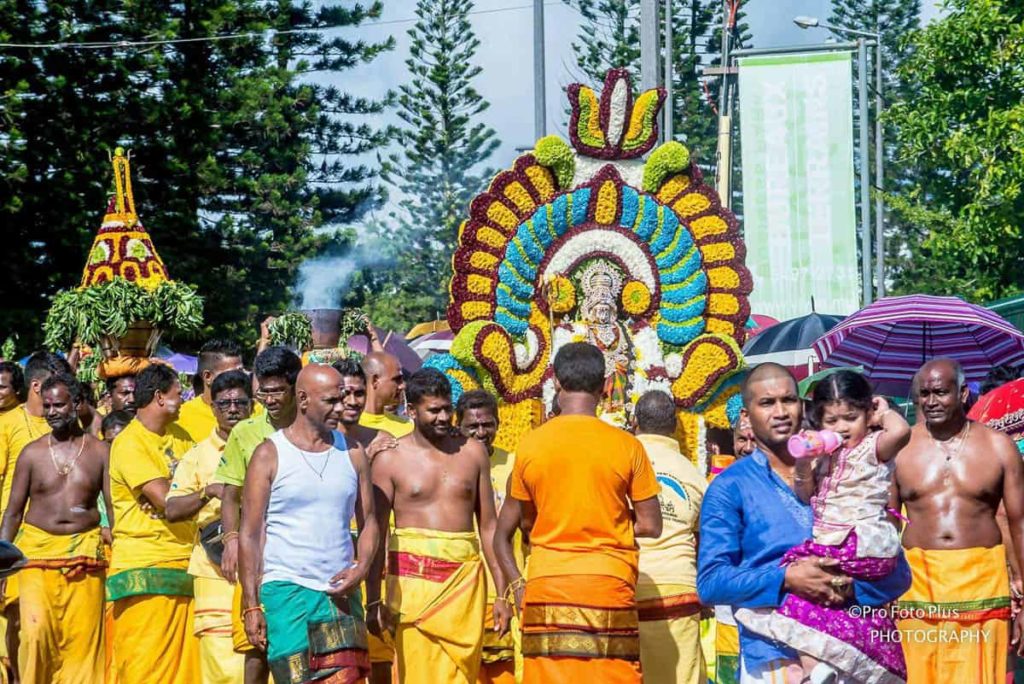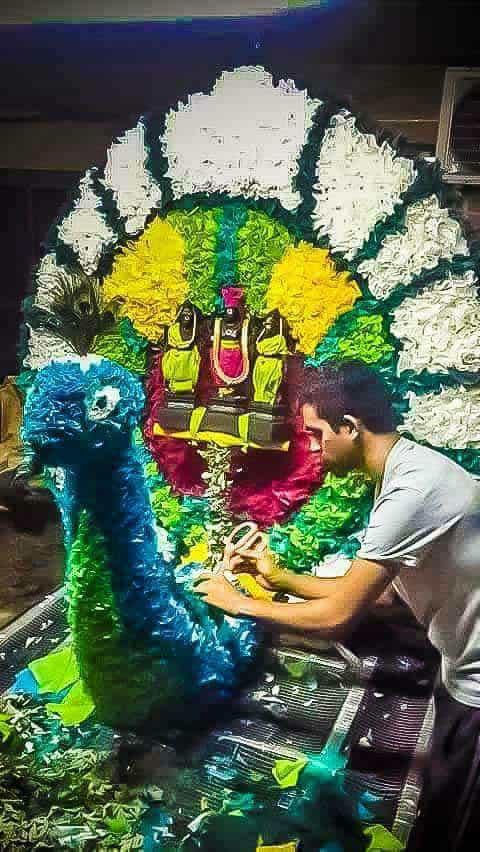
Native Tamils have inherited a rich cultural tradition from their South Indian ancestors who originally came to Mauritius as craftsmen and tradesmen under the French rule years ago. Every year, the majority of Tamils on the island, particularly of Hindu’s origins, celebrate a number of religious festivals determined by the position of the sun and the moon. Among these ceremonies, the Thaipoosam and the Sittirai Cavadee and the walking on fire ceremony (Teemeedee) remain the most prevalent ones. The festivals usually comprise of ten days of fasting and invocatory rituals at the temple. The consecration happens on the tenth day. Accompanied by devotional songs and traditional musical instruments, a hand-pulled cart (raadum or therr in Tamil), adorned to transport an energized effigy ( thiru-uruvatch-sillei) of the main deity (Moolavar), travels the village.
- Goddess Parashakti on the day of Teemeedee at Kannanoor Mariamman Temple, Port Louis
- Devotees (Tamil and non-Tamil) from around Mauritius celebrate together on that day.
- The fire-walking ceremony is in honour of Draupadee Amman.
- Special Floral decorations for Ourvallam (Procession that takes place few days before Teemeedee)
- Adornments of Mariamman, the Mother Goddess
- volunteers donated flowers to create different floral designs during the 10 days of fasting at Kannanoor Mariamman Temple in Port-Louis.
Flowers can be very costly for such decorations, varying between twenty to forty thousand rupees.
Alternative materials for costly flowers
The ornamentation of the cart is essential to the Tamils as it takes the lead of the religious procession on the day of the main ceremony. Along the march, pilgrims carry floral floats and brass pots with milk meant for ablution of the main deity at the temple. The last few years have witnessed a major expansion in cart’s floral decoration in different temples during Tamil festivals. This craft has largely encouraged the effective involvement of young people in the temple activities. For instance, led by a young Mauritian artist named Nileven Allagain, who is actually studying at the School of Fine Arts, a small group of ten people have developed their signature in cart ornamentation. Nileven proved to have an unusual connection with materials in his surroundings and flowers being very costly in Mauritius, he decided to shift to alternative materials for his craft. A more cost-effective way for the adornments was to use natural materials like palm and coconut leaves that are more accessible on the island. He explains that such leaves were chosen among others for the reason that they are already being used for traditional rituals in temples and also for their colour and malleability.
- Coconut and palm leaves ornaments by Nilleven Allagain and his group
- Coconut and palm leaves ornaments by Nilleven Allagain and his group
The designs’ inspirations originated from the kolam, drawing made using rice flour, chalk or chalk powder or natural powder, in front of houses in Tamil Nadu, Maharashtra (Rangoli) and other parts of India. A wooden support is prepared in advance to hold the floral decoration. On the eve of the main celebration, the group spend the whole night weaving, intertwining, plaiting and cutting the leaves to set up a magnificent décor the next morning. A unique and modern artwork takes form but the traditional designs remain. Days after the celebration, the ornament dries up under the heavy Mauritian sun but its beauty does not fade away, it simply undergoes a colouring process, from yellow to gradually turn into different shades of brown.
Well known around the island for his talent, Yasven Ramen takes the flower cart decoration to another level by integrating recyclable materials into his work. He started from a very young age, and he remains grateful to his friends Sivaramen Marday (initiator of the technique ‘Meenakshi Priya’, using only fabrics for ornamentation) and Deerouven Pavaday (flower decoration artist). He pays tribute to his mentor, Deva Singaravellu, a fifty years experienced artist who motivates the younger generation to take over the Tamil floral decoration tradition.
- Procession towards the temple before the Fire Walk Ceremony (Teemeedee)
- Floral decoration at Helvetia Mariamman Temple by Yasven Ramen and his group
Though the young craftsmen area of predilection is flowers, they keep exploring materials like leaves, weeds, fruits and vegetables as well as different types of fabrics. They have created numerous floral decorations during the past years and visibly their works reflect their passion for the craft. Yasven comments that his success resides in his selflessness, perseverance and mostly in the support of his motivated team.
- Cart Decorations using vegetables by Yasven’s team
- Fabrics can be an ideal alternative to costly flowers
It is a craft that has been developed in Mauritius and that is known for its uniqueness and appreciation across the world. Cart decoration has not only developed a feeling of ownership in the youth of the Tamil community but has also bonded generations and different communities. Though satisfied with the success of the projects, each group want to pursue their quest towards original creations that will continue to create awe-inspiring experiences. They all agreed on the fact that the greatest blessing in the selfless service they offered to the temple, is to feel the energy that emanates from the beautified cart that transports the blissful deity on the day of the main ceremony. The Dravidian descendants perpetuate the traditions and promise to preserve the skills brought along by their ancestors to Mauritius.
Author
 Veemanda Curpen is a lecturer in the Printmaking Department at the Mahatma Gandhi Institute. She writes, “I believe in a system that ensures quality, effectiveness and relevance of art education to trainees. As I advance in my practice, I feel very enthusiastic in taking new challenges in the artistic field, for instance, supporting and promoting young talents from Mauritius on an international platform is one of them. My main intention is to engage young people in the artistic field. I hope that my endeavour will prove to be beneficial to the whole Mauritian community.”
Veemanda Curpen is a lecturer in the Printmaking Department at the Mahatma Gandhi Institute. She writes, “I believe in a system that ensures quality, effectiveness and relevance of art education to trainees. As I advance in my practice, I feel very enthusiastic in taking new challenges in the artistic field, for instance, supporting and promoting young talents from Mauritius on an international platform is one of them. My main intention is to engage young people in the artistic field. I hope that my endeavour will prove to be beneficial to the whole Mauritian community.”


